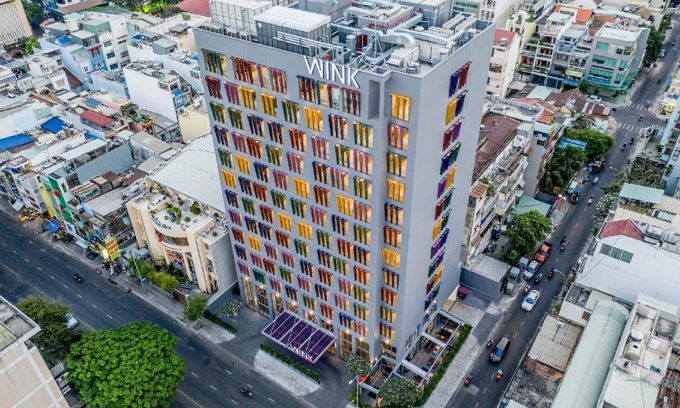Vietnam's luxury hotels survive on domestic tourism wave

According to insiders, the hospitality sector has found solace in the flicker of optimism sparked by the influx of local travelers due to the absence of international tourists.
At the beginning of this month, the renowned hotel company The Grand Ho Tram Strip located in the southern region of Ba Ria - Vung Tau introduced a fresh initiative showcasing 164 apartments and 46 luxurious residences. These newly added accommodations complement the existing 1,100 rooms that have been consistently serving affluent travelers.
Akshay Moza, the vice president of The Grand Ho Tram Strip, expressed the desire of their resort complex to grow further due to the significant rebound of the local tourism industry following the Covid pandemic.
Prior to the global health crisis, the hotel primarily catered to foreign visitors at the resort complex, with a significant customer base from countries like South Korea, China, India, and Indonesia. Conversely, Vietnamese tourists accounted for a mere 7-8% of the overall clientele.
However, ever since the emergence of the Covid pandemic, Vietnamese individuals have made up a significant 80% of the total number of bookings at the resort.
Despite the lifting of travel restrictions and the recommencement of global air travel, just over half of the resort's visitors were international tourists, with the remaining guests hailing from within the country.
The department in charge of a large hotel in the beautiful coastal city of Nha Trang, which boasts a whopping 1,000+ rooms, has shared that the hotel's average occupancy rates have remained consistently high at almost 90% for the past three months. It's noteworthy that a significant 85% of the hotel's visitors are local tourists, which is twice the number of guests seen during the busiest times before the pandemic struck.
Michael Wirz, the overall manager of Zannier Hotels Bai San Ho in Phu Yen, an adjacent area to Nha Trang, refrained from disclosing exact figures. However, he disclosed that local visitors have emerged as the primary clientele at the resort, while the count of international guests is gradually rebounding to reach the levels observed before the pandemic.
The cutting-edge hotel franchise Wink Hotels, which operates one hotel in Ho Chi Minh City and two in Da Nang, achieved an average occupancy rate of 55% during the first six months of 2023. This marked a considerable growth of 26% compared to the latter six months of 2022.
According to Nguyen Hoang Nhu Thao, the marketing manager for Wink in the region, there is an almost equal balance between international and domestic visitors at the chain.
Following the resumption of international tourism in Vietnam, the hotel sector has raised its hopes for a significant increase in overseas visitors. Nevertheless, due to high inflation rates and the absence of direct international flights, the hospitality industry has been compelled to shift its focus to the demand for domestic tourism instead.
According to Wirz, even though we are anticipating changes from the global market, we maintain our belief that the local market will remain a crucial player and an essential component of the broader development scenario.
Statistics have shown a surprisingly speedy recovery of local visitors despite the consistent gloomy state of Vietnam's economy.
As per the Vietnam National Administration of Tourism, the number of local tourists who spent the night in the initial seven months of this year amounted to 46.7 million. This surpasses the total count recorded in 2019, the year preceding the pandemic, where figures stood at 43.5 million.
According to the online data platform Statista, it is predicted that the hotel industry in Vietnam will generate a revenue of $1 billion in the current year.
During the initial six months of 2023, the mean level of hotel occupancy in Hanoi exceeded 57%, denoting a significant increase of 25.5% compared to the corresponding timeframe in the previous year.
There has been a significant rise in accommodation service revenue in various tourist destinations, with certain areas experiencing an increase of over 70%. Notable locations such as Da Nang, Ba Ria - Vung Tau, and Binh Thuan have all recorded substantial growth in revenue, with Da Nang witnessing a 70% rise, Ba Ria - Vung Tau observing a 76% surge, and Binh Thuan experiencing a significant 76.5% increase.
Before the outbreak, foreign visitors played a crucial role in sustaining hotel occupancy during the slow season for local tourists. However, over the past seven months, the volume of international tourists has only reached 67% of its pre-crisis magnitude, with a total of 6.6 million arrivals as opposed to the previous 9.8 million.
Lately, there have been some encouraging signs indicating that international visitors may soon contribute to the revival of the hotel industry.
In the previous month, Vietnam experienced a noteworthy achievement as they received over a million international tourists, breaking a three-year record. Impressively, the number of Chinese tourists returning to Vietnam exceeded those visiting Thailand, securing the top spot.
HSBC suggests that the tourism prospects for Vietnam remain optimistic due to the recent easing of visa regulations.
On June 24th, the National Assembly granted permission to increase the duration of tourist visas from 30 days to 90 days. Moreover, selected countries' citizens will now enjoy a visa-free period of 45 days, starting from August 15th.
According to Walt Power, the CEO of The Grand Ho Tram Strip, the tourism sector hasn't completely bounced back yet, which implies that there are ample opportunities for growth and advancement.

























